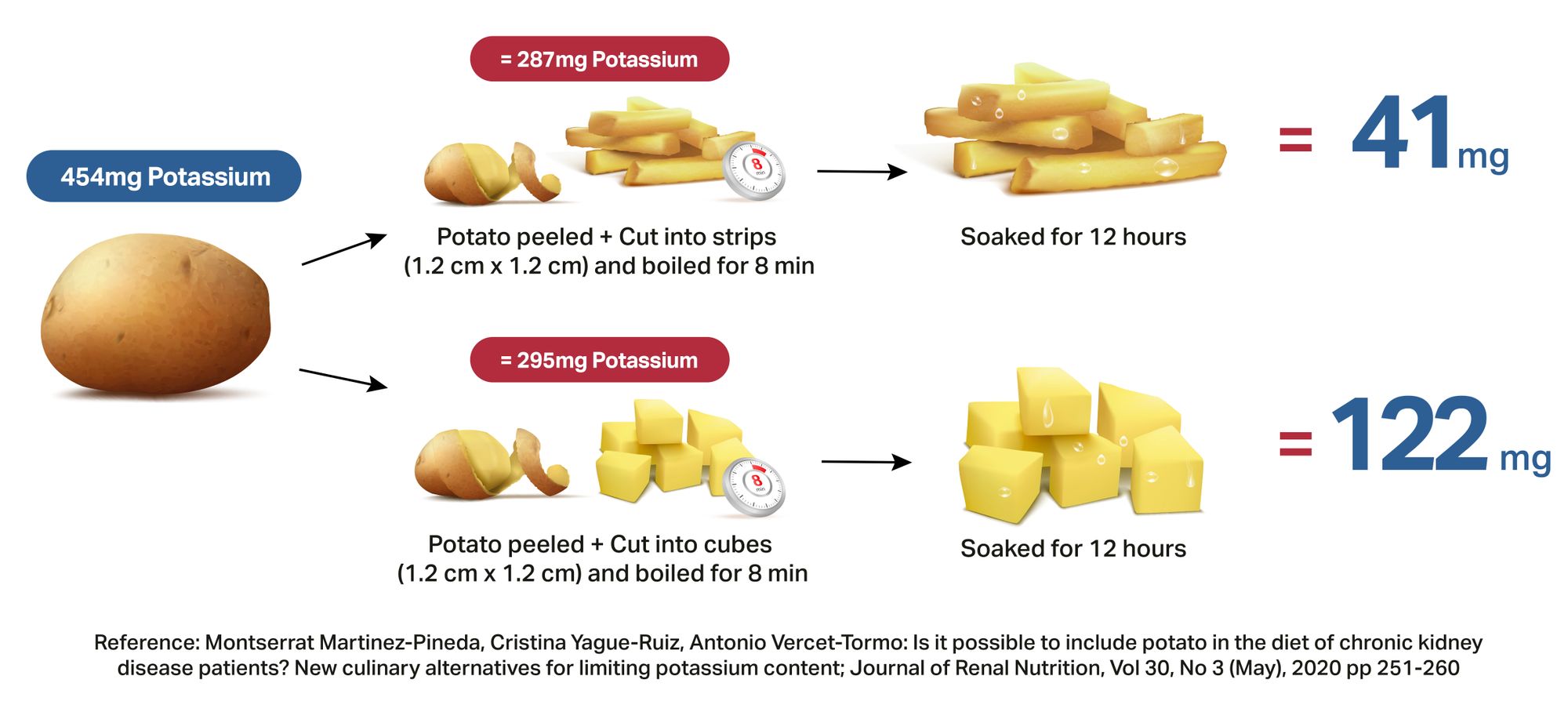Potassium Intake
Potassium is a mineral that has many important roles within your body, including regulating your heartbeat and blood pressure. Maintaining a normal potassium balance is important, as high, or low potassium levels in your blood can affect your heartbeat.
Most foods and beverages contain potassium but in different amounts. If your potassium level is too high and you have been advised by your cardiologist to lower it, changes in your diet can help.
Some medications can also increase your potassium level. If this is the case, your health care team may need to change or adjust a medication accordingly.
Potassium and Potatoes
Potatoes are very high in potassium. However, the way a potato is prepared can reduce its potassium, allowing them be part of a potassium-restricted diet.
Follow the steps listed below when preparing your potatoes to reduce your potassium intake.
Potassium and Legumes
Legumes (lentils, chickpeas, kidney beans, soybeans, etc.) are high in protein, fiber, vitamins, minerals, and certain phytochemicals, such as isoflavones. Legumes are often a part of a Mediterranean diet. Several studies have demonstrated that the regular consumption of legumes provides benefits to adults with type 2 diabetes and cardiovascular disease.
The amount of potassium in plant-based foods varies. For example, tofu and chickpeas are lower in potassium than soybeans and kidney beans.
Traditionally, patients with hyperkalemia (excess of potassium) were advised against eating legumes. Legumes, in addition to vitamins and fibers, contain a lot of protein and minerals such as potassium. Fortunately, a study in 2019 has found that patients can enjoy legumes if certain preparation steps are taken. This study studied chickpeas and lentils.
Soaking and cooking dried lentils and chickpeas can significantly reduce their potassium. A 100 g portion can be included in a potassium-reduced diet. A food is low in potassium if it provides less than 150-200 mg potassium per 100 g portion/serving.
Important: When using canned chickpeas or lentils, the initial quantity of potassium is already low. Soaking will reduce the potassium even further but is not necessary. Make sure to choose canned chickpeas and lentils without salt or rinse before using.
Follow the steps listed below when preparing legumes to reduce your potassium intake.
Low Potassium Food Guide
To help you avoid foods that are high in potassium, follow examples suggested in our guide below. Please note that organizations may use different cut-off levels to decide which foods are high or low in potassium. Therefore, you may find some variations among resources.
Note that ½ cup is 1 serving unless otherwise stated.
Our examples below are a guide and not to replace the advice of your health care provider.
Speak to your dietitian about the number of servings that is right for you or to identify low-potassium foods that are not captured on this list, including foods from various cultures.
Dairy
Although non-chocolate dairy has less potassium than their chocolate versions, dairy is considered a high potassium food choice. Please limit to ½-1 cup (125-250 ml) per day or as per the recommendation of your Dietitian or Healthcare Team.
Choose:
- Fresh milk
- Pudding
- Ice cream
- Yogurt
Avoid:
- Chocolate milk
- Ice cream and yogurt containing chocolate and/or nuts.
Fruits
Limit to 3 servings per day, or as recommended by your registered dietitian.
Choose (example of 1 serving):
- 1 apple
- Applesauce
- 10 cherries
- ½ mango
- 1 Peach
- 1 Pear, medium
- 1 Plum
- Raspberries
- Strawberries
- Blueberries
- Blackberries
- Pineapple
- Apple juice
- Pineapple juice
- Cranberry juice or cocktail
- Nectars from guavas, peaches, and pears
Avoid:
- Apricots
- Avocados
- Bananas
- Coconut, dried and raw
- Cantaloupes
- Nectarines
- Oranges
- Honeydew melons
- Kiwis
- Papayas
- Coconut, orange, and prune juices
- Coconut water
Do not eat starfruit (also known as carambala, bilimbi, belimbing, Chinese starfruit, star apple) if you have kidney problems.
Grains
Choose (example of 1 serving):
- Bread, bagels, and rolls made with 60% whole wheat, light rye, or white flour
- Corn or rice-based cereals (Corn Flakes, Rice Krispies, cream of rice, cream of wheat, non-bran cereals
- White pasta
- White pita
- Crackers (cream, graham, matzo, water, soda)
- White melba toast
- White rice, wild rice
- White rice cakes
- Tortilla chips
- Barley, buckwheat (kasha), bulgur, cornmeal, couscous, white flour.
Avoid:
- Bread, bagels, and rolls made with whole grain, 100% whole wheat, or dark rye
- Other cereals (bran, whole grain, granola, shredded wheat, those with dried fruit and nuts)
- Whole wheat pasta
- Brown rice
- Quinoa.
Vegetables
Limit 3 servings per day, or as recommended by your registered dietitian.
Choose (example of 1 serving):
- Onion
- Broccoli, chopped, raw, or frozen
- Beans, green or wax
- Mushrooms, raw
- Carrots, raw (16cm long or 8 baby carrots)
- Carrots, boiled and drained
- Okra, raw or boiled and drained
- Peppers
- 1 cup green peas, frozen, boiled, or canned and drained
- Raw peas
- Asparagus (5 spears)
- 1 celery stalk, raw
- 1 cup of lettuce
- Cauliflower, raw or cooked
- 1 cup cucumber, sliced
- Corn kernels, frozen, canned, or boiled and drained
- Snow peas, raw (10 pods)
Avoid:
- Tomato sauce
- Mushrooms cooked
- Rapini (cooked)
- Bok choy, cooked
- Brussel sprouts, cooked
- Juice- vegetable, clamato, V8 or tomato
- Potatoes, sweet potatoes (unless prepared according to the cooking instructions listed above or below-place this info where you feel it fits best).
Additional Items
Choose:
- Coffee or tea
- Butter, margarine, oil, or mayonnaise
- White sugar, sugar substitutes, honey, jam, pancake syrup
- Non-cola beverages
- Herbs and spices, pepper, herb mixes
- Unprocessed meat, fish, poultry, and cheese
- Popcorn, pretzels, corn chips (low sodium options)
- Nut butter, but limited to 1 tbsp per day.
Avoid:
- Specialty coffees (cappuccino, Turkish coffee, espresso)
- Canned coconut milk
- Chocolate
- Potato chips
- Nuts and seeds
- Colas
- Brown sugar
- Maple syrup
- Salt-free cheese or processed meats with potassium added
- Salt substitutes containing potassium chlorides (Nu Salt®, No Salt® and Half Salt®)
Avoid foods that list potassium or the chemical symbols (K, KCl or K+) as an ingredient on the label.



 Sharon Bray
Sharon Bray
 Paula Henderson
Paula Henderson
 Isabel Victal
Isabel Victal
 Cindy
Cindy